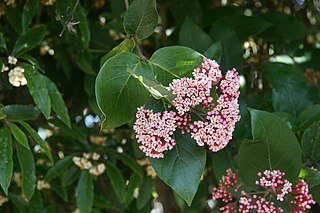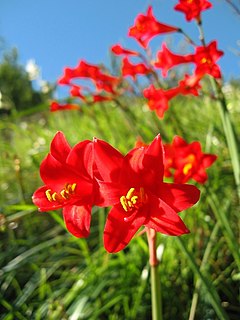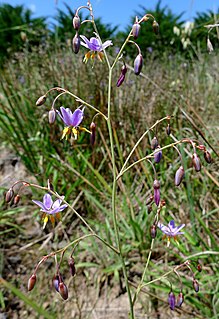
The lazuli bunting is a North American songbird named for the gemstone lapis lazuli.

Clarkia is a genus within the flowering plant family Onagraceae. Over 40 species are currently classified in Clarkia; almost all are native to western North America, though one species is native to South America.

Clarkia amoena is a flowering plant native to western North America, found in coastal hills and mountains from British Columbia south to the San Francisco Bay Area.
Emily Jean Stevens (1900–1967), usually known as Jean Stevens, was a New Zealand iris hybridiser in the 1940s and 1950s who created the 'Pinnacle' iris as well as a number of other outstanding amoenas.

Astereae is a tribe of plants in the family Asteraceae that includes annuals, biennials, perennials, subshrubs, shrubs, and trees. Plants within the tribe are present nearly worldwide divided into 170 genera and more than 2,800 species, making it the second-largest tribe in the family behind Senecioneae. They are found primarily in temperate regions of the world.
Amphiachyris is a genus of flowering plants in the family Asteraceae described as a species in 1840.
Xanthocephalum is a genus of North American plants in the aster tribe within the sunflower family.

Changnienia is a genus of flowering plants from the orchid family, Orchidaceae. Only one species is known, Changnienia amoena, native to China.

Leptopterna is a genus of plant bugs in the Miridae family.
Broomweed is a common name for several species of plants, including:

Amphiachyris dracunculoides, commonly called broomweed, is a North American species of flowering plants in the family Asteraceae. It is native to the United States, primarily the southern Great Plains from Missouri to eastern New Mexico.

Vexatorella is a genus containing four species of flowering plant, commonly known as vexators, in the family Proteaceae. The genus is endemic to the Cape Floristic Region of South Africa. The name means “little trouble-maker”, given with reference to the initial difficulties of placing V. latebrosa within the family. All species are shrubs which occur in dry fynbos habitats on the fringes of the Succulent Karoo ecoregion. The inflorescences are similar to those of the related leucospermums but also share features of the leucadendrons, with the floral bracts becoming woody and enlarged following pollination. The flowers are insect-pollinated, with the seeds dispersed by ants (myrmecochory).

Rogiera amoena is a shrub or small tree in the family Rubiaceae, sometimes grown as an ornamental plant. Common names include rondeletia and yellowthroat rondeletia. The species is native to Mexico, Belize, Guatemala, El Salvador, Nicaragua, Costa Rica and Panama.

Phycella is a genus of herbaceous, perennial bulbous flowering plants belonging to the family Amaryllidaceae, subfamily Amaryllidoideae. The genus consists of five species distributed from central Chile to northwestern Argentina.
Caladenia amoena, commonly known as the charming spider orchid, is a plant in the orchid family, Orchidaceae, and is endemic to Victoria. It is a ground orchid which grows singly or in small groups, has a single dark green, hairy leaf and a single yellowish-green flower with red stripes. It is only known from a few sites and has been classified as Endangered.
Mesovelia amoena is a species of water treader in the family Mesoveliidae. It is found in the Caribbean Sea, Central America, North America, Oceania, and South America.

Vexatorella amoena, also known as the Swartruggens vexator is an evergreen shrub of up to about 1 m (3 ft) high, that is assigned to the family Proteaceae. It has entire, inverted egg-shaped, bluish grey, leathery leaves of 1½–3 cm (0.6–1.2 in) long and 5–11 mm (0.20–0.45 in) wide on a distinct stalk, and globular flower heads of about 2 cm (0.8 in) across with pale pink flowers with extended, thick-tipped styles at the tip of the branches. The plants are flowering from September to November. It is an endemic species that is restricted to the Western Cape province of South Africa.

Felicia amoena is a variably hairy, sometimes glandular, biennial or perennial plant, of about 25 cm (10 in) high, that is assigned to the family Asteraceae. It is somewhat woody at its base, roots at the nodes if these contact the soil, and has ascending branches. The leaves are oppositely arranged along the stems at and just above a branching fork, further up the leaves alternate. The flower heads sit individually on up to 12 cm long stalks. They are 2–3 cm in diameter and consist of about twelve to twenty five heavenly blue ray florets that surround many yellow disc florets. Three subspecies have been recognised, that differ in width of the leaves and the involucral bracts, the size of the heads and number of ray florets and in having glandular hairs. These can be found in coastal sands and inland areas in the Western Cape and Eastern Cape provinces of South Africa. Flower heads can be found from June till October.

Acacia amoena, commonly known as boomerang wattle, is a shrub belonging to the genus Acacia and the subgenus Phyllodineae that is native to parts of eastern Australia.

Dianella amoena, commonly known as the matted flax-lily, is an endangered, herbaceous, perennial plant endemic to Australia. It belongs to the family Asphodelaceae, subfamily Hemerocallidoideae. It has long grey-green leaves which grow in clumps from an underground rhizome, and displays blue-purple flowers in spring-summer, up to 90cm in height. The common name Matted Flax-lily refers to its extensively rhizomatous nature, sometimes forming large mats up to 5m wide.












